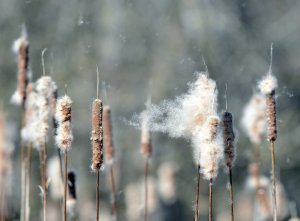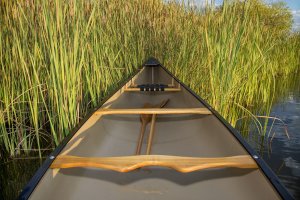The Versatile Cattail
June 28, 2023
By Steve Dishman, Interpreter, Lake St. Clair Metropark
If you live on the coastal areas of Michigan, you are no doubt familiar with the hearty cattail. Cattails by the hundreds seem to fill every coastal cove or wetland spot. Cattails are important for many species, including waterfowl, marsh wrens, red-winged blackbirds, muskrats… and humans, also. Believe it or not, cattails have uses for people other than attracting wildlife for viewing.

Historically, Native American tribes around the area called the Anishinabek, recognized multiple uses for cattails. For one, they could harvest cattail leaves in the fall, and after drying the leaves, they were threaded and weaved using animal bones to make a mat, which could be used to transport items or used to cover dome structures for a warm shelter in the winter. These cattail mats usually lasted only a couple of years, so it was important to collect fresh leaves every autumn.
Cattails also are a food source to people as well as wildlife. The rhizomes, or roots, can be ground into flour or boiled or baked. The taste of boiled cattail rhizome reminds some of artichokes. In late spring or early summer, the shoots near the base of the leaves can be cooked or even eaten raw or in salads. The taste reminds some of cucumber, scallions, or celery. Even the sap of cattails can be used as a thickener for broth or soups. Of course, if gathering cattails for human consumption, don’t pick cattails in areas they are protected or where collection is prohibited. Finally, make sure to research more detailed cooking descriptions.

We’ve discussed uses of cattail roots, leaves, and even the sap. But what about the fluff on the cattails? The Anishinabek also used the fluff for flour, but they found that it was useful as well for insulation. It could be used insulate footwear, bedding, and even boats. Because of its buoyant properties, the United States’ government during World War II tested using it in life vests. It does work well as a buoyant material, but the fluff is flammable.
We hope you enjoyed learning more about the versatile cattail. We invite you to visit some wetlands at a Metropark near you either by land or water. Lake St. Clair, Oakwoods, and Stony Creek Metroparks even offer tours on replica Voyageur canoes throughout the summer. We hope to see you soon at your Huron-Clinton Metroparks!

